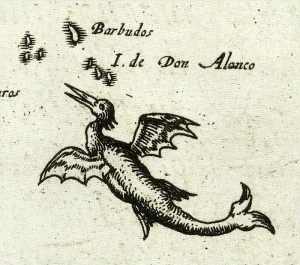The “Ropen” of Papua New Guinea
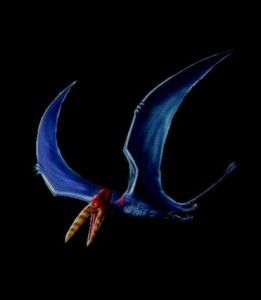 Shortly after World War II, as western missionaries began to penetrate the deep jungles and remote islands of Papua New Guinea (PNG), stories of a flying creature called the Ropen (“demon flyer”) began to be reported. Duane Hodgkinson was stationed east of Lae, near Finschaven, PNG as part of the Army cavalry in 1944. About noon one day in August he was walking down a trail through a clearing in the forest when he was startled by a crashing in the brush. As he watched a large bird-like creature ponderously rose from the ground, circled and flew away. Hodgkinson, a pilot, estimated the wing-span to be that of a small airplane, about 25 ft. He clearly recalls the dark-gray coloration, long serpentine neck, beak, and distinctive head crest. Described as a nocturnal creature, the Ropen possesses two leathery wings like a bat, a long tail with a flange on the end, a beak filled with teeth, and razor-sharp claws. An intriguing sea chart dated 1595 warns mariners to beware of a variety of “sea monsters.” It depicts two flying creatures (See below on right) with a long necks, headcrests, ribbed wings and fantastical tails (split on the end like a flipper) flying above the islands of New Guinea. One is even shown as having dermal bumps. (Sweeney, James B., A Pictorial History of Sea Monsters, 1972, p. 42.)
Shortly after World War II, as western missionaries began to penetrate the deep jungles and remote islands of Papua New Guinea (PNG), stories of a flying creature called the Ropen (“demon flyer”) began to be reported. Duane Hodgkinson was stationed east of Lae, near Finschaven, PNG as part of the Army cavalry in 1944. About noon one day in August he was walking down a trail through a clearing in the forest when he was startled by a crashing in the brush. As he watched a large bird-like creature ponderously rose from the ground, circled and flew away. Hodgkinson, a pilot, estimated the wing-span to be that of a small airplane, about 25 ft. He clearly recalls the dark-gray coloration, long serpentine neck, beak, and distinctive head crest. Described as a nocturnal creature, the Ropen possesses two leathery wings like a bat, a long tail with a flange on the end, a beak filled with teeth, and razor-sharp claws. An intriguing sea chart dated 1595 warns mariners to beware of a variety of “sea monsters.” It depicts two flying creatures (See below on right) with a long necks, headcrests, ribbed wings and fantastical tails (split on the end like a flipper) flying above the islands of New Guinea. One is even shown as having dermal bumps. (Sweeney, James B., A Pictorial History of Sea Monsters, 1972, p. 42.)
Two species appear to persist in PNG. A smaller pterosaur is believed to inhabit the caves that dot the islands of Rambunzo in the Bismarck Archipelago. Reports seem to fit the presumed-extinct Rhamphorhynchus, a pterosaur with a wingspan of 3-4 feet. Like the Kongomato in Zambia, the Ropen is said to have a taste for decaying human flesh and has even harassed native funeral gatherings with western missionaries present. Carl E. Baugh of the Creation Evidence Museum conducted an expedition to Manus. With missionary Jim Blume, he observed one of the creatures through a monocular night scope and snapped a picture of a strange print in the sand the next morning. In 1987, Tyson Hughes, an English missionary, began an 18 month contract to assist the Moluccan tribespeople of Ceram Island, Indonesia to develop efficient farms. Tyson heard stories about a terrifying creature called the Orang-bati (“men with wings”) that possesses enormous leathery wings like a bat and live in the caves of Mount Kairatu, an extinct volcano situated in the center of the island. Likely this creature is similar to the Ropen from adjoining PNG. Stories from the people of Sunda, Indonesia tell of the Jurik, a flying dragon whose illuminated profile could be seen in the night sky. (Knappert, J. Pacific Mythology: An Encyclopedia of Myth and Legend, 1995.) In 2017 Genesis Park staff followed up on reports from the jungles of Cambodia of a similar creature there. After hiking several days in the bush along the border with Vietnam a number of eye witness accounts were obtained. A nocturnal, flying, snake-like creature is known there by the name of “Sat-el-law,” though the sightings are very rare.
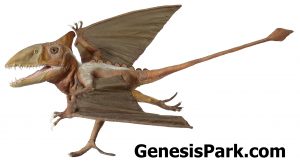 In October of 2004, Genesis Park staff conducted a three week trip to the remote Siassi island off the western coast of Papua New Guinea, somewhat south of the Manus island group. The goal was to hike into the mountainous interior of Siassi to follow-up on intriguing reports received from coastal communities on the south of the island. Dozens of interviews were conducted and the credibility of witnesses was carefully tested by the use of black and white profiles. After carefully collating the dozens of interviews, a composite drawing (left) of most likely characteristics possessed by the Ropen was assembled. (Modified from D.K. Images of England after being procured. Click to enlarge.) The creature appears to resemble the Dimorphodon pterosaur, with the addition of a head crest and dermal bumps. However, the animal is said to have a 15-20 ft wingspan.
In October of 2004, Genesis Park staff conducted a three week trip to the remote Siassi island off the western coast of Papua New Guinea, somewhat south of the Manus island group. The goal was to hike into the mountainous interior of Siassi to follow-up on intriguing reports received from coastal communities on the south of the island. Dozens of interviews were conducted and the credibility of witnesses was carefully tested by the use of black and white profiles. After carefully collating the dozens of interviews, a composite drawing (left) of most likely characteristics possessed by the Ropen was assembled. (Modified from D.K. Images of England after being procured. Click to enlarge.) The creature appears to resemble the Dimorphodon pterosaur, with the addition of a head crest and dermal bumps. However, the animal is said to have a 15-20 ft wingspan.
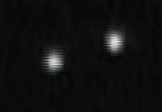
2006 PNG Expedition Photo Taken by Paul Nation
The most remarkable thing about the Ropen is that indigenous people claim it displays a bioluminescent glow. This glowing phenomenon had been observed and noted by biologist 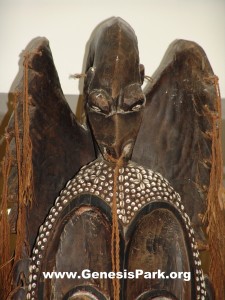 Evelyn Cheeseman back in the 1930s. She wrote about the mystery in her 1935 book The Two Roads of Papua, “It was a most intriguing mystery; because by no possibility could there be human beings out there using flash-lamps at intervals . . . In any case they were too far to be caused by an ordinary electric torch.” Our expedition staff observed this bioluminescent phenomenon as well. On Wednesday, October 27 a large, yellowish glow approximately 20-25% the size of the full moon was observed to fly behind one of the volcanic peaks. The light left no trail and it twinkled around the edges. The whole sighting lasted for only a few seconds, as the light streaked across the horizon and behind Mt. Tolou. Our team also investigated an interesting local artifact…an intriguing carvings made by an unknown artisan (right). The statue shows a medicine man with a reptilian creature on his neck/shoulders. The creatures display a lizard-like ear, forked tongue, elongated snake-like neck, shallow beak, scaly membrane wings, dermal bumps running down its back, webbed feet, and a long tail (in one case being swallowed by a crocodilian). In the fall of 2006 a follow-up expedition obtained the first photograph of a Ropen light as multiple creatures were observed flying over a ridge at night.
Evelyn Cheeseman back in the 1930s. She wrote about the mystery in her 1935 book The Two Roads of Papua, “It was a most intriguing mystery; because by no possibility could there be human beings out there using flash-lamps at intervals . . . In any case they were too far to be caused by an ordinary electric torch.” Our expedition staff observed this bioluminescent phenomenon as well. On Wednesday, October 27 a large, yellowish glow approximately 20-25% the size of the full moon was observed to fly behind one of the volcanic peaks. The light left no trail and it twinkled around the edges. The whole sighting lasted for only a few seconds, as the light streaked across the horizon and behind Mt. Tolou. Our team also investigated an interesting local artifact…an intriguing carvings made by an unknown artisan (right). The statue shows a medicine man with a reptilian creature on his neck/shoulders. The creatures display a lizard-like ear, forked tongue, elongated snake-like neck, shallow beak, scaly membrane wings, dermal bumps running down its back, webbed feet, and a long tail (in one case being swallowed by a crocodilian). In the fall of 2006 a follow-up expedition obtained the first photograph of a Ropen light as multiple creatures were observed flying over a ridge at night.
In 2015 a Canadian team went to the island of New Britain and had a daytime sighting of what they believe was a Ropen flyover. The similarities in the several independent lines of evidence produce a powerful argument for living pterosaurs in Papua New Guinea. A missionary pilot’s experience, an ancient map, an American WWII veteran’s testimony, a Highland native’s sculpture, and dozens of eye witness reports from across the region (Indonesian islands through out PNG and even Vanuatu) combine to make a strong case! For more information, see the full Expeditions page.

